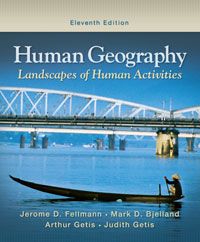1.
A) True B) False 2.
A) culture realm, culture region, culture complex, culture trait B) culture trait, culture region, culture complex, culture realm C) culture complex, culture region, culture realm, culture trait D) culture trait, culture complex, culture region, culture realm 3.
A) fracturing B) homogenization C) regionalizing D) hierarchy 4.
A) possibilism. B) environmental determinism. C) regionalism. D) diffusionism. 5.
A) possibilism B) environmental determinism C) regionalism D) diffusionism 6.
A) True B) False 7.
A) in close proximity to each other B) more isolated from each other 8.
A) increased hunting of wild animals B) more gathering of wild fruits and berries C) more emphasis upon food cultivation D) decreased population due to disease 9.
A) domestication of animals B) domestication of plants C) animals and plants were domesticated simultaneously D) depended upon where the domestication took place 10.
A) seed crops B) vegetatively reproduced crops C) Neither one D) Both 11.
A) True B) False 12.
A) Mayan B) Egypt Old Kingdom C) Minoan Crete D) Mesopotamian E) All of the above 13.
A) mentifacts B) sociofacts C) artifacts D) justdafacts E) All of the above 14.
A) mentifacts B) sociofacts C) artifacts D) all of these E) none of these 15.
A) mentifacts B) sociofacts C) artifacts D) sendafacts E) None of the above 16.
A) contagious and hierarchical B) cascade and stimulus C) relocation and contagious D) expansion and hierarchical E) expansion and relocation 17.
A) True B) False 18.
A) telegraph B) telephone C) radio D) television E) Internet 19.
A) hierarchical B) cascade C) stimulus D) relocation 20.
A) Yes B) No 21.
A) cascade B) relocation C) reverse hierarchical D) stimulus 22.
A) assimilation B) acculturation C) transculturation D) transformation 23.
A) Yes B) No 24.
voodoo among enslaved Africans brought to Louisiana?A) Roman Catholicism B) Masonic rites C) American Indiana spiritual practices D) All of the above 25.
Guns, Germs, and Steel , Jared Diamond attributes the conquest by Europeans of the Americas, Africa, Pacific Islands, and portions of Asia to a host of factors. Which among the following is not put forward as a reason by Diamond?A) Eurasia's abundance of cultivatable plants B) Eurasia's supply of large animals suitable for domestication C) Eurasia's east-to-west orientation of similar climates and landforms D) Eurasia's biological stock of advantageous racial characteristics 26.
A) cultural trait. B) cultural realm. C) cultural complex. D) cultural hearth. 27.
A) cultural attainment. B) cultural divergence. C) cultural significance. D) technological divergence. 28.
A) slow. B) having a cultural gap. C) in the state of refusion. D) experiencing a cultural lag. 29.
A) the initial stage of relocation diffusion spreading further than if it were spreading by expansion diffusion. B) relocation diffusion is strictly centralized while expansion diffusion is strictly linear. C) expansion diffusion intensifying the concept, idea or trait in the place of origin while relocation does not. D) relocation expansion causing the idea, concept or trait being practiced to wane in its place of origin or even disappear, while expansion diffusion does not. 30.
A) the earth's topography B) distance C) man-made laws D) All of the above can acts barriers.





